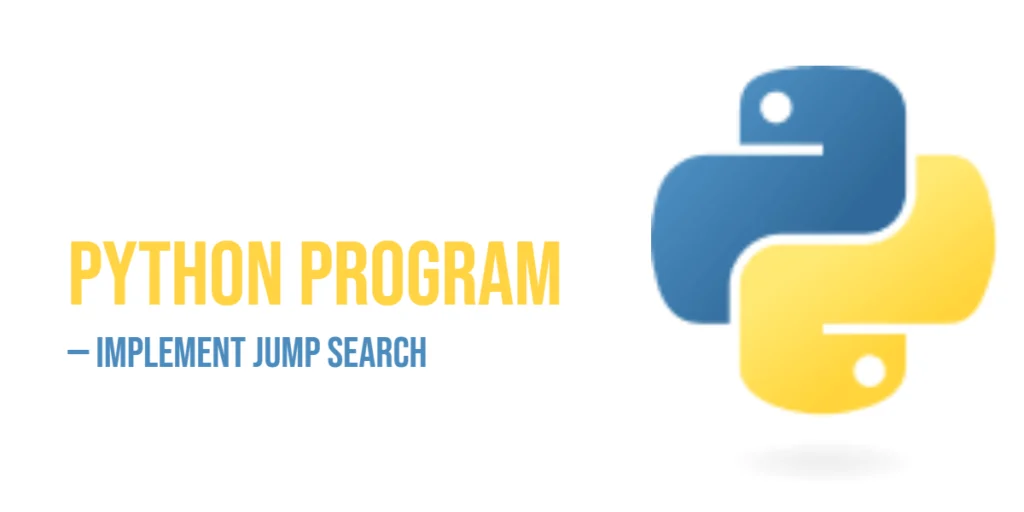Searching for elements efficiently is a core skill every programmer needs, and Jump Search is a smart algorithm designed to do just that. Unlike linear search, which checks each element one by one, Jump Search “jumps” ahead by fixed steps and then performs a linear search in the relevant block. This makes it faster than linear search on large, sorted datasets while remaining simple and easy to implement, which is perfect for beginners.

with hands-on learning.
get the skills and confidence to land your next move.
Jump Search is commonly used in situations where data is sorted and you want faster performance than linear search without the complexity of binary search. Applications include searching phone directories, finding records in databases, and efficiently navigating structured datasets. In this article, we will explore multiple ways to implement Jump Search in Python, from basic iterative methods to reusable functions and robust error-handled versions, so beginners can easily follow along.
Program 1: Iterative Jump Search
This program demonstrates the basic iterative approach to Jump Search. It jumps ahead in blocks and then searches linearly within the block where the target element might exist.
import math
numbers = [10, 20, 30, 40, 50, 60, 70, 80]
target = 50
n = len(numbers)
step = int(math.sqrt(n))
prev = 0
while numbers[min(step, n)-1] < target:
prev = step
step += int(math.sqrt(n))
if prev >= n:
print(f"Element {target} not found in the list")
exit()
for i in range(prev, min(step, n)):
if numbers[i] == target:
print(f"Element {target} found at index {i}")
break
else:
print(f"Element {target} not found in the list")In this example, the program calculates the optimal jump size using the square root of the list length. It jumps forward until it finds the block that may contain the target and then searches linearly within that block. Beginners can see how combining jumping and linear search reduces the number of comparisons compared to checking every element.
Program 2: Jump Search Using a Function
This program wraps the Jump Search logic in a reusable function, making it easy to call with different datasets and targets.
import math
def jump_search(numbers, target):
n = len(numbers)
step = int(math.sqrt(n))
prev = 0
while numbers[min(step, n)-1] < target:
prev = step
step += int(math.sqrt(n))
if prev >= n:
return -1
for i in range(prev, min(step, n)):
if numbers[i] == target:
return i
return -1
numbers = [5, 15, 25, 35, 45, 55, 65]
target = 35
result = jump_search(numbers, target)
if result != -1:
print(f"Element {target} found at index {result}")
else:
print(f"Element {target} not found in the list")Using a function allows the search algorithm to be reused multiple times without rewriting code. Beginners can understand the importance of modular programming and how functions make the code cleaner and more maintainable.
Program 3: Jump Search Using Recursion
Jump Search can also be implemented recursively, which provides another way to understand the block-wise approach.
import math
def jump_search_recursive(arr, target, prev=0, step=None):
n = len(arr)
if step is None:
step = int(math.sqrt(n))
if prev >= n:
return -1
if arr[min(step, n) - 1] >= target:
for i in range(prev, min(step, n)):
if arr[i] == target:
return i
return -1
return jump_search_recursive(arr, target, prev + int(math.sqrt(n)), step + int(math.sqrt(n)))
numbers = [2, 4, 6, 8, 10, 12, 14, 16, 18, 20]
target = 14
result = jump_search_recursive(numbers, target)
if result != -1:
print(f"Element {target} found at index {result}")
else:
print(f"Element {target} not found")In this recursive version, the function jumps forward by fixed steps and calls itself until the target block is found. Then, a small linear search identifies the exact position. Beginners can learn how recursion can replace loops while keeping the logic of Jump Search intact. It also reinforces understanding of step calculations and boundary checks.
Program 4: Jump Search with Dynamic Step Size
This program demonstrates adjusting the jump size dynamically based on the remaining elements, which can slightly improve efficiency.
import math
def dynamic_jump_search(numbers, target):
n = len(numbers)
step = int(math.sqrt(n))
prev = 0
while prev < n and numbers[min(step, n)-1] < target:
prev = step
step = min(step + int(math.sqrt(n - prev)), n)
for i in range(prev, min(step, n)):
if numbers[i] == target:
return i
return -1
numbers = [2, 4, 6, 8, 10, 12, 14, 16]
target = 12
result = dynamic_jump_search(numbers, target)
if result != -1:
print(f"Element {target} found at index {result}")
else:
print(f"Element {target} not found in the list")By adjusting the jump size according to remaining elements, the search can become slightly more efficient. Beginners can practice algorithm optimization while still keeping the code simple and understandable.
Program 5: Jump Search on a Large Dataset
This example highlights how Jump Search performs on a larger dataset, showing its efficiency over linear search.
import math
numbers = list(range(0, 300, 3)) # 0, 3, 6, ..., 297
target = 150
n = len(numbers)
step = int(math.sqrt(n))
prev = 0
while numbers[min(step, n)-1] < target:
prev = step
step += int(math.sqrt(n))
if prev >= n:
print(f"Element {target} not found in the list")
exit()
for i in range(prev, min(step, n)):
if numbers[i] == target:
print(f"Element {target} found at index {i}")
break
else:
print(f"Element {target} not found in the list")Even with 100 elements, Jump Search reduces the number of comparisons significantly by jumping forward in blocks. Beginners can compare this with linear search and understand the practical benefits of block-based searching.
Program 6: Jump Search with Error Handling
This program demonstrates a safe implementation that handles empty lists or targets that are not present.
import math
def safe_jump_search(numbers, target):
if not numbers:
return -1
n = len(numbers)
step = int(math.sqrt(n))
prev = 0
while prev < n and numbers[min(step, n)-1] < target:
prev = step
step += int(math.sqrt(n))
if prev >= n:
return -1
for i in range(prev, min(step, n)):
if numbers[i] == target:
return i
return -1
numbers = [5, 15, 25, 35, 45]
target = 25
result = safe_jump_search(numbers, target)
if result != -1:
print(f"Element {target} found at index {result}")
else:
print(f"Element {target} not found in the list")Error handling ensures the algorithm won’t crash when given an empty list or when the target does not exist. Beginners can see how to write robust, real-world-ready code while keeping the algorithm simple.
Frequently Asked Questions (FAQ)
Jump Search is simple yet effective, and beginners often have questions about its usage and efficiency. Here are some common queries:
Q1: What is Jump Search used for?
Jump Search is used to find elements efficiently in sorted lists by jumping ahead in fixed steps and reducing comparisons compared to linear search.
Q2: Can Jump Search work on unsorted data?
No, Jump Search requires the list to be sorted to work correctly.
Q3: Is Jump Search faster than binary search?
Jump Search is faster than linear search for medium-sized datasets, but binary search is generally more efficient for very large datasets.
Q4: How is the jump size calculated?
The optimal jump size is typically the square root of the list length, which balances jumping and linear search within blocks.
Q5: Why should beginners learn Jump Search?
It introduces efficient block searching, practical optimization, and the combination of linear and block-based algorithms in an easy-to-understand way.
Conclusion
Jump Search is a beginner-friendly, efficient algorithm for searching sorted lists. By implementing it in Python using iterative, function-based, dynamic, and error-handled approaches, learners can practice reducing search time while understanding arrays, loops, and algorithm design.
Practicing these programs helps beginners understand the logic behind block-based searching and optimization techniques. Start with small examples, experiment with different step sizes, and try robust implementations for real-world scenarios. The more you practice, the more confident you’ll become in writing efficient and reliable algorithms in Python.







